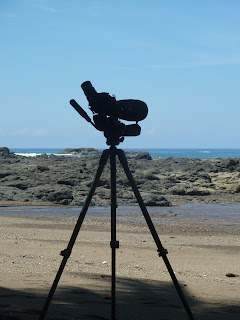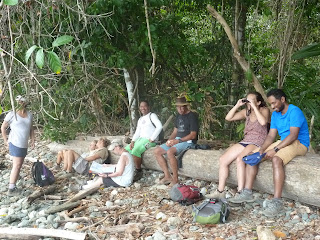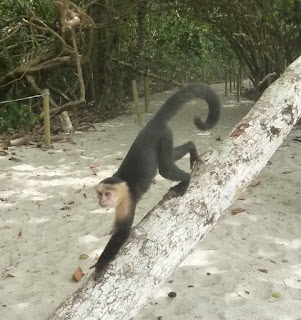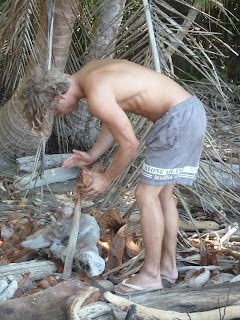For people all over the world, Costa Rica’s
famed natural beauty is the stuff of travelling dreams. Europeans seem especially enamoured of Costa
Rica’s attractions and when by trail or street one passes another tourist it is
folly to assume that English will be their natural tongue.
As we write this post, we have ranged as
far south as Bahia Drake and are now returned to Playas del Coco, waiting for a
good weather window to transit the Nicaraguan coast back towards Bahia del Sol in
El Salvador. The shore vegetation here
in the north of Costa Rica is dry. Last
night, driven by strong northerly winds there was a raging brush fire that glowed
fearsome orange up the southern banks of the bay’s hills. But during our
southward journey the forests slowly changed to lush greenery, accented in the
myriad shades of blooming tree flowers.
Along the way we saw and heard many a
monkey. Howler monkeys make themselves loudly known whether you can see them or
not. Their grunts and roars are easily
heard at anchor, far from their tree-top lounge chairs where they laze away
their days. Spider monkeys are not noisy
but use their long limbs to range energetically through the forests above in
search of food. Don’t stand beneath
them: you may get wet or worse! Tiny
little squirrel monkeys do the same but are the more endangered and you need to
be luckier to get a sighting. Capuchin white-faced monkeys are often seen
ranging on the forest floor. They are
clever and are known for their thievery, encouraged by stupid tourists who have
previously succumbed to the temptation to feed them.
At Punta Quepos the vibe was like a mini
Wreck Beach, but without the nudity.
From the street above there is a steep trail down to the beach, where
vendors sell beer and drinks and delicious food is on offer. Umbrellas are available to rent and Costa
Ricans and tourists show up in equal numbers to enjoy lazy days spent on the
beach. Our access was by dinghy, but we
trekked up the hill to enjoy the luxury of a meal pool-side and then a small
provisioning run at the nearby neighborhood commercial area. The curvy road from beach to town sweeps past
many swish looking vacation villas that have been built into the steep
hillsides overlooking the sea. At night
everyone goes home from the beach, leaving cruisers all alone at anchor to
listen to a private concert of cicadas and monkeys.
Beautiful anchorage at the 'Wreck Beach' (clothing required) of Punta Quepos.
Around the corner is the Manuel Antonio Park. Anchored there we took our dinghy and enjoyed
the trails to ourselves before the hordes of tourists began being admitted at
8am. Coatis and agoutis and bats were
about, along with monkeys and sloths that we couldn’t see, hidden high up in
the foliage. Apparently, the sloths come
from aloft once every 8 days to take a dump in the roots of their tree, then
climb back up. Why they do this is
unknown and especially puzzling because predators such as puma and jaguar are
known to take advantage of their moment of slothful ablution.
What happens when a tricky dingy surf landing tangles with the line of a parasailer?
Quiet reflection after a violent pitch into the sea. Luckily, the dingy stayed upright even if Alice and Greg did not.
Uvita was a stop on the way to Drake
Bay. An unpleasant night was spent
rolling and bouncing at anchor there. At
low tide the reef absorbs the swells but woe betides the high – then the swell
rolls in over the reef and makes life miserable. If you want to have a really lousy memory of
a place all that is required is to combine a lumpy anchorage with a valve
accident that emptied our full water tanks into the sea and then air-locked the
water maker needed to refill them. Sweaty hours below were required to set
things right.
Greg has bad memories of Uvita, but the stunning sunset and rising moon are Alice's fond memories.
Bahia Drake was a highlight reel of nature’s
beauty. Not being ourselves much in the
way of naturalists, we chose to enjoy the experience assisted by tour guides
for both water and land. First was a dive/snorkeling trip by boat to Isla del
Cano. Greg’s two dives at the island
were simply spectacular displays of underwater life. Huge schools of jacks, big and small, swirled
in circles that envelope you swimming gracefully inches from your body and including
you in their fantastic flying formations. On underwater rock spires that rise
from a sandy bottom, moray eels lurked, lobsters hid in crevices, eagle rays
glided by and white-tipped and bull sharks lingered on the sea-floor. Tuna fish ripped above at high speed while
stingrays nestled hidden in the sand below, their eyes and nostrils and the
faint outlines of their bodies giving away their secret locations. It was a
profusion of sea life. Triggerfish and grunts and snappers. Wrasse, damselfish and parrotfish. Boxfish, puffers and porcupinefish. Lace coral and hawkfish. Wow.
Snorkeling and dive trip to Isla del Cano.
The next day we went on a trip to Corcovado
National Park, sleeping overnight in a tent at ranger station San
Pedrillo. We roared at 26 knots to our
park landing beach near Sirena Ranger Station, stopping on the way to watch a
very large school of mobular rays leaping up and splatting down by hundreds in
a rhythmic visual symphony.
Spotting the wildlife thanks to Donny, our expert guide.
Overnight camping at San Pedrillo Ranger Station in Corcovado Park.
The young panga drivers were skilled at managing the gringos in and out of the tour boat.
Our guide Donny was of aboriginal descent
and besides being friendly and fun to be around, he carried an encyclopedic
knowledge of all things forest living.
The trip was in its way a repeat for Alice, as eight years previously
she had hiked in 20km from the Golfito side of the park. She had then flown out on a small plane from
the grass strip at Sirena. It turns out
that a high accident rate has now closed that runway. Small plane wreckage can be seen in 5 places
around the strip, causing Greg to be impressed anew by his esposa intrépida.
The abandoned landing strip.
The profusion of life at sea was matched by
that of the land. Of plants and trees
there was a jungle. Of animals were
numerous monkeys but also tapirs (similar to a pig), sloths curled up high in
trees, agouti (like really weird looking rabbits), coatis (long nosed raccoons),
and squirrels. Of birds there were
scarlet macaws, toucans, and other small birds of many colour (technical term
for birds whose names we didn’t catch).
There were black hawks, falcons, turkey vultures, cormorants, egrets,
herons, sandpipers and plovers, gulls and terns and grouse. Lizards were many, small and large and there
were dart frogs (toxic to touch and previously used by aboriginals to poison
their weapon tips). And insects: huge
spiders with elaborate 3-dimensional webs capable of catching small birds, swarming
wasps and bees and ants and termites and nasty tiny little ticks (perhaps the
least favourite of all insects), along with the usual assortment of mosquitos
and biting sand fleas to remind us that we humans can also be prey.
Donny once killed one of these wasps, leaving the pheromone on his skin. The entire hive chased him for miles (well maybe not miles)!
Invisible to us but roaming the jungle were
huge jaguars and their smaller puma and ocelot cousins. Snakes were few this time of year, for which
in a way we were glad, though we would have loved to see a boa constrictor
hanging from a tree. Greg went for a
cooling swim in the ocean and then was told it was a bad idea – crocodiles often
range there out of the estuary. Oops.
Adding to the visual pleasures of a trek
through exotic trails were other human animals.
We were accompanied on our explorations by a stunningly beautiful and
smart-minded young 20ish Danish couple, living embodiments of blonde god and
goddess. They were youth in love and
adventuring the world together. Lucky them;
lucky us: all alive in nature’s jungle.
The young Danish couple shelling coconuts.
Greg & Alice































No comments:
Post a Comment